QuestionQUESTION: Hello Diane,
My name is matt and I own a 6 year old leopard gecko. I've been looking for some professional help and it became more difficult than i thought, so i hope I've come to the right place. There is no emergency, issue, or illness I just have some questions. Also I've heard many opinions and i really would like facts.
First I want to address the substrate debate, mainly on sands. I'm currenly using newspaper in a 20 gal aquarium. I used to use sand, but soon feared impaction then switched to cage carpet, which snagged on his claws. He seems to have trouble with shedding because his feet slip on the newspaper, so I don't know what to do. My next attepmt will be slate rock as a substrate, covering the cage floor with sand between the cracks. So is there a safe digestible sand, or should I even chance it? What do you think?
Next I'd like to know if I should give him something other than crickets and calcium suppplement? Like fruit or worms?
Right now he just gets crickets. Usually 1 or 2 per day or 3 - 4 every other day.
Finally I'm wondering if i could introduce another leopard gecko, a baby, into his eviroment. I've heard of the territorial issue and the possibilily of the baby being eaten, but he's never been aggressive and seemed very friendly toward the toads I had in a seperate tank next to him. ( Acctually I'm not sure what gender my gecko is. I assume male. ) So if it is possible, should I introduce another male, or a female? Or introduce a few at once?
Should I set the new geckos in a tank next to him to get used to each other? Would it help if I created a completely new layout, environment, and cage while introducing a new gecko?
Thank you for any help you can offer there is no hurry.
Also could you direct me elsewhere if you cannot help.
Thank you
ANSWER: Hi Matt,
I am going to give you a care sheet that I wrote to help people out with leo care. All of your questions are actually answered in there..but I will touch on each one a bit separately..
Sand..you did well in removing it as it can and is deadly to leos...see the link in the care sheet below showing what does happen.
I use the slate tiles, which are not smooth with children's playsand under them to stabilize them and also distribute the heat. There really is no safe sand and something that encourages them to eat it, IE: calci sand is even more deadly. With the slate tiles, there is no visible sand.
Adding some branches, fake plants, etc gives them something to rub against to help loosen shed as of course the humid hide is vital for the shedding process also.
Leos should be fed as much as they can consume in about 15 minutes. Daily or every other day feeding is the best.Crickets, superworms, freshly shed(or home raised mealworms, silkworms are all good leo foods. An occasional treat of a few waxworms is fine also. You can offer some fruits, the leo may lick at it or even take a bite as some will, most won't but it won't hurt to offer it. I have one that loves to lick at watermelon..and its good for hydration.
Leos really do prefer to live alone and are 100% content with being alone.
You cannot introduce a baby into an adults cage..the adult will most likely kill the baby, be it for a meal or territorial issues.
Males cannot ever be housed together...females can be housed together in most circumstances, but should be the same age, size and introduced to the cage at the same time to prevent any issues. Males and females....generally they will get along but then you have the breeding issues and some over aggressive males can harm females. Constant breeding and egg laying is also very stressful on the female as is constant breeding on the male. I would not try to introduce another leo into your current leos cage.
If you wish to get more leos, I would suggest a new tank with females that are young. Good breeders in most cases only place the female with the male during breeding season for a short period of time and good breeders will wait until the female is around 55-60 grams in weight and a year old or more..with older being better.
Here is a link to pictures of sexing your leo. http://www.reptilecare.com/leopardgender.htm
I'm hoping I have answered all of your questions and that it has helped you out!!!! Thank you for the wonderful questions!!
BASIC CARE FOR A LEOPARD GECKO
Leopards are pretty easy to care for but they do need
special care. Here are some of the basic needs of your gecko.
HOUSING: The need to have at least a 20 gallon long tank for one Leo. This needs to have a secure fitting screen top...they can be quite the escape artists!!! They need to have a humid hide box.You can make this with something as simple as a small plastic dish with a hole cut in one side and a small mesh bag filled with some Sphagnum moss coconut bark or Peat moss that you mist.
I made mine out of the small plastic folgers coffee containers...I cut an opening in the lid..and put the moss in..they LOVE it. I use the terrarium moss in mine.
I use that on the warm side of the tank. Be sure to provide a cool hidebox on the other end. I also provide a mid temperature hide...which is in the middle of the tank.I use the critter caves which you can purchase. NOT the ones that have heat in them!!!!
Provide secure climbing areas for your gecko. Fake plants, rocks and branches are all fine to use. be sure there are no wires or sharp ends to any fake plants you use.
*****SUBSTRATE:(that's the stuff on the floor of your tank) Newspaper, lizard carpet or paper towels work great and are easy to clean and are much safer than any loose substrate. Sand or other loose substrate is not recommended as that they can be deadly to the leo when it is ingested(eaten, even by accident while eating their insects)...A very graphic site of an impacted leo surg can be seen at http://homepage.mac.com/exoticdvm/reptile/PhotoAlbum181.html it is very graphic!!! ******What I have found that works great for safety and heat distribution is using about 1/4 inch of childrens play sand(since the tiles fit tight together, there is no sand danger) on the bottom of the tank and on top that you place ceramic or slate floor tile. What is nice is that the 12 x 12 squares fit perfect in a 20 gallon tank with no spaces between the tiles. The sand and the tile distribute the heat wonderfully. Using the under tank heater as described is what distributes the heat. Also, overhead heat will help in heating the tiles...I've been using this set up for several years and the leos love it. Using a tile that isn't smooth is recommended. **********
TEMPERATURES: They need a warm area ( on the floor) of 88-92 degrees and a
cooler area in the upper 70s, low 80s. At night their temperature can drop to the low to mid 70's.
Never use a hot rock for a leopard gecko...or any reptile.
They can severely burn any reptile. You can use a heating
pad under the tank,under tank heater for the warm area. You can use a regular household lightbulb in a dome fixture with a ceramic socket in it to keep the warm area at the 88-92 degree area if needed there, otherwise, placing the lightbulb about midway in the tank will give the needed temperatures throughout the tank. You may have to play with the wattage of the bulb but generally 40-60 watts is sufficient.At night, no white light. If room temperatures stay above 70 degrees, no extra night heat is needed. The undertank heater or heating pad should cover about 1/3 of the tank....be sure to raise the tank up about 1/4-1/2 inch off the stand when using an undertank heat source to prevent heat build up which can cause the glass to break and hot spots in the glass. Be sure to have a good layer of newspaper, carpeting or, even a thin flat rock(such as tile) on top the area that the undertank heat source is placed...if you use a thin rock or tile, it helps to distribute the heat very well.
You can use the special nighttime lights that are designed for reptiles. I like using a ceramic heat emitter on a thermostat for nighttime heat.
DO NOT use black lights or party lights as they can cause eye damage!!!!
The wattage you use will vary based on room temperature and size of tank.
LIGHTING: Leopard geckos do not need UVB lighting but it does not hurt them to give them uvb. They should have some type of light during the day, be it a uvb tube, regular florescent light, reptile day light or regular household lightbulb. NO white lights at night!!!
FEEDING: Geckos should not be fed crickets or other insects that are bigger than the space between their eyes. Generally, hatchlings can be fed more than once a day,juvys can be fed twice a day, adults are fed once daily or every other day, in the early evening. Crickets and other food items such as silk worms, super, and an occasional treat of a wax worm, need to be dusted with a calcium supplement two times a week and also they should have a small dish of calcium in their tank. I use the lid of a milk jug for the little dish of calcium in their tank. For dusting the insects, Use a calcium with no added phosphorus. Insects must be gut loaded(fed) for at least 48 hours prior to feeding your gecko. Remove any uneaten crix or superworms after 15-20 minutes..... Place a piece of cut potato in the tank so that if you have missed any uneaten insects, they will eat the potato instead of nibbling on your gecko!!!
*************You have to be sure to feed your crickets and insects the right foods before feeding them to your gecko. If your crickets/insects are not healthy and well fed, your gecko will not get the nutrition he needs. You can gut load your crickets and insects greens, veggies, cereals or specially designed commercial foods for crickets or the insects you are feeding. ************
Be sure to have a small dish of clean water for your gecko at all times!!
You can offer them some baby food or fruits on occasion ...
Mine will even eat a small piece of watermelon now and then.WATER: always provide a dish of drinking water. If you choose to mist your gecko to drink, its best to not get the tank too wet as that they do not do well with higher humidity. Sometimes its better to take your leo out of their tank to mist them to get them to drink!!!
HANDLING: Some geckos enjoy being held...others prefer not to be handled at all. Be sure to be very gentle when holding your leo and NEVER grab them by the tail! Their tails are extremely fragile and will break.
I do suggest finding a vet that can treat reptiles BEFORE you actually need one!!! To find a vet that is able to care for reptiles:
http://www.herpvetconnection.com
http://www.arav.org/ECOMARAV/timssnet/amm/tnt_mdsearch.cfm
http://www.anapsid.org/vets/
For more information on leopard geckos:
http://www.drgecko.com
If you have any questions or don't understand something, please let me know.
---------- FOLLOW-UP ----------
QUESTION: Thank you for your information you sent me this week, it was very useful and helpful. But now I have an issue I believe could possibly be an emergency. I do not know of any pet clinics that could help me. I have just this morning found what looks like blood in my geckos urine, and tracked a few inches from the spot. This has never happened before. As mentioned previously I do not know the gender, but I assume male. I put two pieces of bagged butter lettuce in his tank for the first time ever last night. Could that have something to do with it? There were only two crickets in his cage last night so I dont think they could have harmed him. He seems uninjured as far as i can see. Can you tell me what to do?
AnswerHi Matt,
Did you check the links I sent you on finding a vet? If not, refer back to that post please.
As to the lettuce..... I doubt your leo would eat the lettuce and if he did, it would not cause a problem. Leos aren't known to eat greens, etc...but some may lick at or nibble on some fruit.
If he ate the insects, it may be blood from a cricket or possibly some internal parasites. If he is acting fine in all aspects then I would just contact a vet and ask about if they feel its an emergency. Only you know the amount of the blood....if it was just a small smear,then it may be nothing. If it was a large amount and fresh then it can be a problem. If today, or tomorrow, when he goes to the bathroom again, and its the same, then I would surely have him checked out and have a fecal check done for internal parasites.
Other causes of discolored urates can be dehydration. You may want to offer some water from an eye dropper or spray bottle. You can also soak him in a shallow pan of warm(90 degrees) water. The water should not be any deeper than his elbows when he is laying flat.

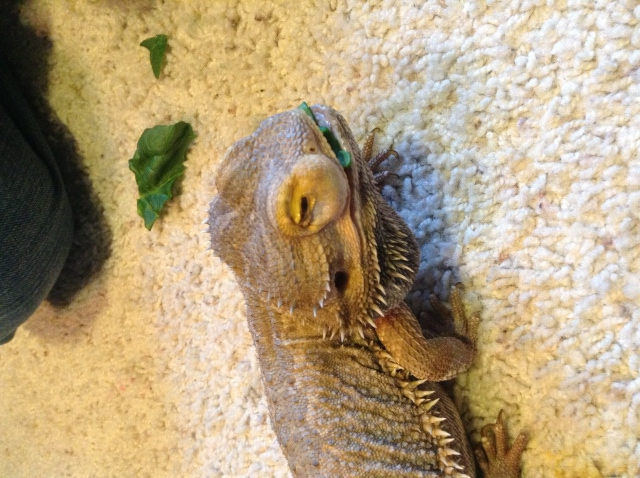 Rex hypovitaminosis A
Question
Rex Rex
This is the picture of hi
Rex hypovitaminosis A
Question
Rex Rex
This is the picture of hi
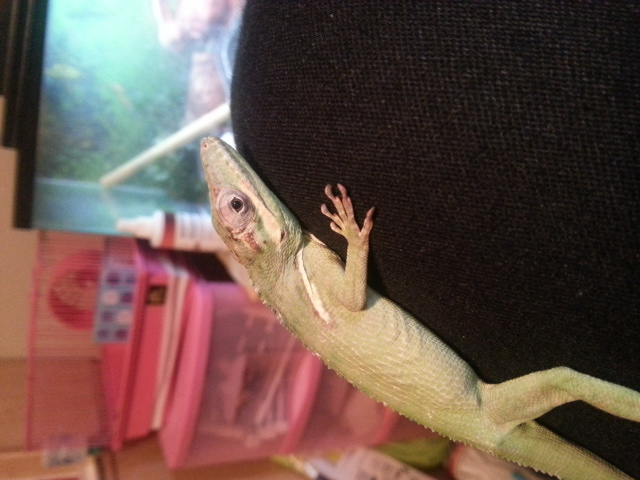 Cuban Knight Anole
Question
Grimm
Hello! I have a four month old Kn
Cuban Knight Anole
Question
Grimm
Hello! I have a four month old Kn
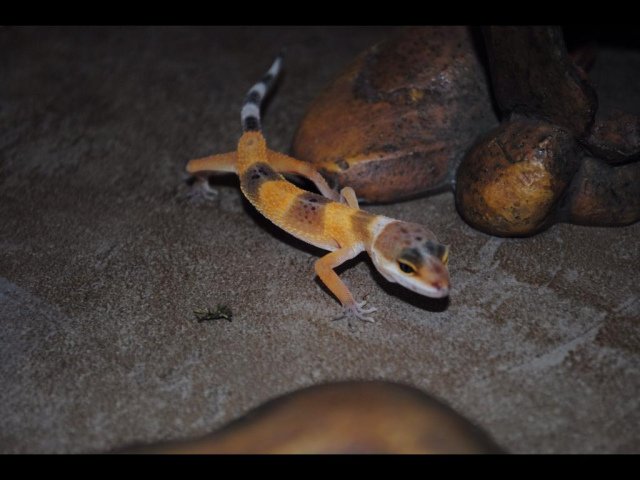 Picture of my leo
Question
My baby Leo
Hey,Sorry I had to make another qu
Picture of my leo
Question
My baby Leo
Hey,Sorry I had to make another qu
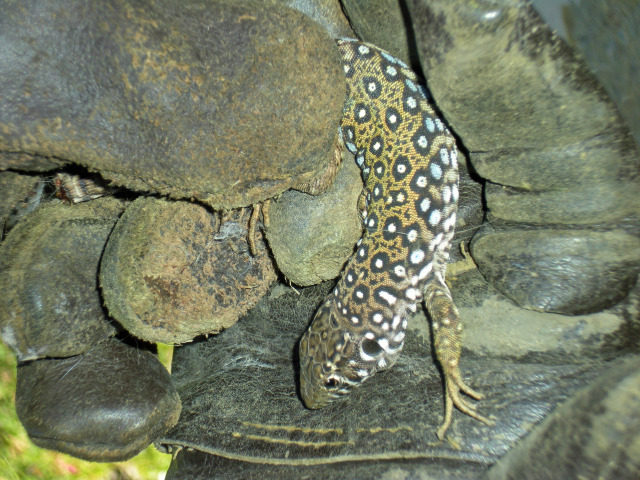 Sand Lizard
QuestionUnknown lizard
QUESTION: Could you help
Sand Lizard
QuestionUnknown lizard
QUESTION: Could you help
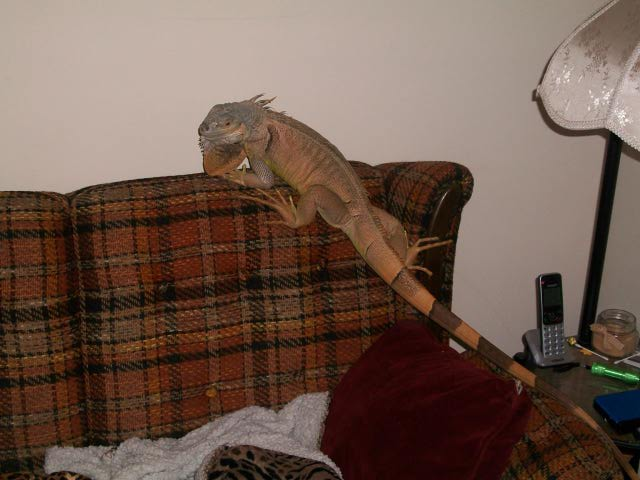 Green Iguana
QuestionJade
Jade
QUESTION: hello i Bough
Green Iguana
QuestionJade
Jade
QUESTION: hello i Bough